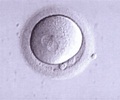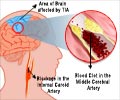According to surgeons, they use sound waves to pulverize gallstones and now stroke experts are trying to determine if less powerful ultrasound can
According to surgeons, they use sound waves to pulverize gallstones and now stroke experts are trying to determine if less powerful ultrasound can improve the efficacy of the clot-busting drugs used to restore blood flow to the brain. Dr. Andrei Alexandrov, of the University of Texas, said he was using intracranial ultrasound to track the efficacy of the clot-busting drug called tPA or alteplase.
Shortly after initiating the ultrasound monitoring, emergency room nurses told him patients "were getting better really fast." At that point, he decided to initiate a pilot study to determine if ultrasound could boost the clot-busting or thrombolysis ability of tPA, he explained Friday during a news briefing at the 27th International Stroke Conference in San Antonio.Alexandrov uses a hand-held ultrasound device fitted into a frame "like the frame inside a construction worker's hard hat," he said. Using a Food and Drug Administration-approved diagnostic frequency setting of 2 megahertz, the device focuses on the clot while the tPA is infused over a period of about an hour and then continues to track the clot for an hour after infusion.
Alexandrov said sound waves are very powerful and a low thumping "could mechanically shake apart a clot." But that approach would be dangerous because it would be difficult to control. The FDA approved diagnostic frequency is "faster but gentler. It creates micro-vibrations that work on the surface of the clot to open up more surface that the tPA can then bind to and penetrate," he said.
The pilot study enrolled 40 patients, average age 65. Thirty-seven percent had complete clearance of clots, called recanalization, within two hours of treatment initiation and "70 percent had a partial clearance of clots," Alexandrov said in an interview with United Press International.
He cautioned, however, the pilot study was designed to test the safety not efficacy of the approach. "We did prove that ultrasound is safe when used in this way," he said. Dr. Gregory del Zoppo, of Scripps Research Institute in La Jolla, Calif., and a member of the American Stroke Association's executive committee told UPI ultrasound "has been looked at by a number of investigators. There is no doubt that sound waves can (break-up) clots, but safety is a concern."
While Alexandrov's study, which was designed as a safety trial, found no safety problems using the diagnostic ultrasound devices, del Zoppo said he doubts such low power devices actually improve the recanalization rate of clot-busting drugs. The temptation, he said, will be to use more powerful devices "and that's where safety becomes an issue."
Advertisement
Moreover, del Zoppo said the recanalization rates cited by Alexandrov are not especially high. But Alexandrov said his early results are so promising a new phase II study aimed at determining the most effective frequency has already begun. So far 30 patients have been treated and the goal is to enroll 120 patients.
Advertisement











